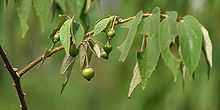Muntingia
| Muntingia | |
|---|---|
_in_Hyderabad%2C_AP_W_IMG_9597.jpg) | |
| Scientific classification | |
| Kingdom: | Plantae |
| (unranked): | Angiosperms |
| (unranked): | Eudicots |
| (unranked): | Rosids |
| Order: | Malvales |
| Family: | Muntingiaceae |
| Genus: | Muntingia L. |
| Species: | M. calabura |
| Binomial name | |
| Muntingia calabura L. | |
| Synonyms[1] | |
| |

Muntingia calabura, the sole species in the genus Muntingia, is a flowering plant native to southern Mexico, the Caribbean, Central America, and western South America south to Peru and Bolivia.[2] Common names include (English) calabur tree, capulin, Jamaica cherry, Panama berry, strawberry tree,[3] Singapore cherry, Sabah cherry, Bajelly tree; (Filipino) aratilis, and saresa; and (Cebuano) mansanitas.

It is a small tree 7–12 metres tall with tiered and slightly drooping branches. It has serrated leaves 2.5–15 cm long and 1–6.5 cm wide. The flowers are small, white and slightly malodorous. It gives rise to 1–1.5 cm light red fruit. The fruit is edible, sweet and juicy, and contains a large number of tiny (0.5 mm) yellow seeds.
It is a pioneer species that thrives in poor soil, able to tolerate acidic and alkaline conditions and drought. Its seeds are dispersed by birds and fruit bats. It is cultivated for its edible fruit, and has become naturalised in some other parts of the tropics, including southeastern Asia. As a pioneer plant, it could help condition the soil and make it habitable to other plants. However, it might also be considered as an invasive species since it might out-compete indigenous plants.
Uses
In Mexico, the fruits are eaten and sold in markets. The fruits can be processed into jams and the leaves can be used for making tea. In Brazil, the trees are planted along river banks. The fruits falling from the tree attract fish that are then caught. In the Philippines and Indonesia the fruits are usually eaten mostly by children although they are not sold in the markets. The skin is slightly tough and often discarded by children.
In traditional medicine, its leaves can be used as an antiseptic, antipruritic and to treat abdominal cramps.
The timber from what is also known as the Jamaican cherry, is reddish-brown. It is compact, durable and lightweight and can be used for carpentry. It could also be used as firewood. The bark can be used to produce ropes and fiber for bark skirts. Due to its ability to grow in poor soil and its effective propagation by means of bats and birds, it could be used for reforestation projects.
In India, it is used in urban gardens for its ability to grow fast and attractiveness to small fruit eating birds such as the flowerpeckers. It is also commonly planted in parking lots.
Another study claimed that aratilis leaves possess antinociceptive (reducing sensitivity to pain), anti-inflammatory, antipyretic and antipruritic properties, justifying the folkloric medicinal use.
Habitat
In the Philippines, the trees are commonly visited by different species of birds. It also attracts bats and nocturnal animals that feasts on the sweet juice of the fruit. This aides for the fast widespread propagation of the muntingia in the Philippine forests which sometimes overpopulate an area in just a couple of years. With just enough sun and water, it grows with little or no care. This is apparent in the island of Maldives where Muntingia, locally known as "Jeymu" grows without any care in very salty sand. The Malaysian common name "Ceri Kampung" means "village cherry". In Malaysia the muntingia tree is found in many urban areas lining the sides of streets in front of rows of houses. There, the muntingia produces great quantities of fruit. People eat the fruits freely and is still left plentiful for everyone, even for the birds, and rarely seen to be sold on the market. Children climb these trees to pick the fruit and fill tubs for themselves and their family to eat. Fruit from Muntingia is also harvested for export overseas. In places where the climate is inhospitable to the Muntingia, the fruit is considered a luxury and sold at a premium.
Taste
These cherries are very sweet and taste similar to cotton candy. They also taste like blueberries that are very ripe.
Growing
This is a fast-growing fruit tree, 2 years to be a 3-metre tree. After the flowers are pollinated, there will be lots of the berries growing. Once they ripen, the flowers start to bloom again. After one crop of berries is harvested, the flowers will pollinate back into fruit. The fruit tree will grow for many years.
Gallery
-
_in_Hyderabad%2C_AP_W_IMG_9597.jpg)
flower in Hyderabad, India.
-
_on_Singapur_cherry_(Muntingia_calabura)_W_IMG_9605.jpg)
Common Emigrant Catopsilia pomona on its flower in Hyderabad, India.
-

trunk in Hyderabad, India.
-

leaves & flowers in Hyderabad, India.
-

leaves & flowers in Hyderabad, India.
-
_on_Singapur_Cherry_(Muntingia_calabura)_W_IMG_9602.jpg)
Common Jay Graphium doson on its flower in Hyderabad, India.
-
Muntingia calabura flower
Notes
- ↑ "The Plant List: A Working List of All Plant Species". Retrieved 27 December 2014.
- ↑ Boning, Charles R. (2006). Florida's Best Fruiting Plants:. Sarasota, Florida: Pineapple Press, Inc. p. 111.
- ↑ Germplasm Resources Information Network: Muntingia calabura
